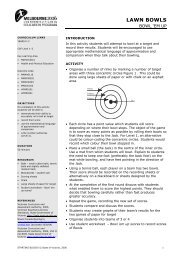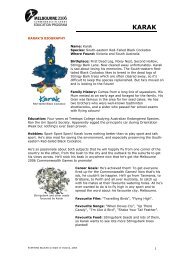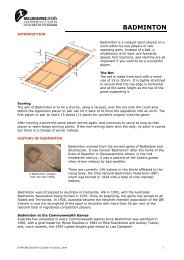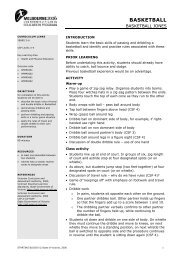gymnastics rhythmic - Education Program
gymnastics rhythmic - Education Program
gymnastics rhythmic - Education Program
You also want an ePaper? Increase the reach of your titles
YUMPU automatically turns print PDFs into web optimized ePapers that Google loves.
HISTORY OF RHYTHMIC GYMNASTICS<br />
GYMNASTICS<br />
RHYTHMIC<br />
The appearance of Rhythmic Gymnastics dates to the end of<br />
the nineteenth century, through ideas that developed on the<br />
expression of movement and the development of rhythm. As a<br />
competitive discipline, Rhythmic Gymnastics began in the<br />
former Soviet Union in the 1940s.<br />
Performing with the hoop<br />
The International Gymnastics Federation (FIG) recognised the<br />
new discipline in 1961, while the first World Championship for<br />
individual contestants was staged in Budapest in 1963.<br />
The group events were introduced in the competition schedule in 1967, at the World<br />
Championships held in Copenhagen.<br />
Rhythmic Gymnastics was introduced as an official Olympic discipline in the 1984 Los Angeles<br />
Olympic Games program, while the first group competition was introduced twelve years later,<br />
in 1996, at the Atlanta Olympic Games.<br />
Rhythmic Gymnastics at the Commonwealth Games<br />
Rhythmic Gymnastics first appeared at the Commonwealth Games in 1990 in Auckland, New<br />
Zealand. At the 1994 Games in Vancouver, Canada, Australian Kasumi Takahashi won all five<br />
individual gold medals in Rhythmic Gymnastics.<br />
ABOUT RHYTHMIC GYMNASTICS<br />
Rhythmic gymnasts compete on a floor area of 13m square. A<br />
balanced composition is achieved between the gymnast, the<br />
apparatus and the music, plus required difficulties. The<br />
apparatus must be used in both hands, thrown into the air<br />
and kept in constant motion. Rhythmic gymnasts also<br />
compete in levels 1–10 or in an international stream.<br />
There are five apparatus in Rhythmic Gymnastics:<br />
Performing with the ball<br />
o Balls o Club<br />
o Hoop o Ribbon<br />
o Rope<br />
Ball<br />
The ball must rest in the gymnast's hand and not against the<br />
wrist. The elements include rolling, throwing and bouncing.<br />
The gymnast must use both hands while showing continuous<br />
flowing movement over the whole floor area.<br />
Performing with the ball<br />
STARTING BLOCKS © State of Victoria, 2004 2








